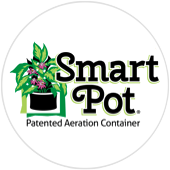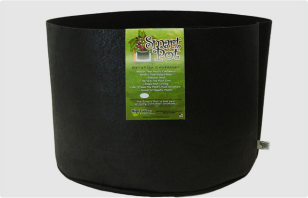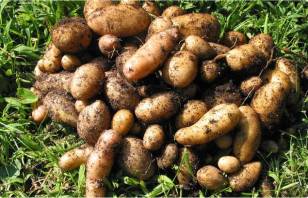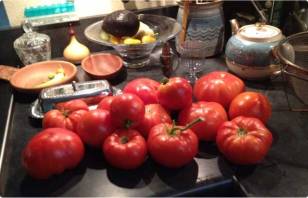At a glimpse: A study comparing the growth of rose bushes in traditional plastic containers versus Smart Pots. The results: Growth was greater in fabric pots than in conventional plastic containers, reductions in root zone temperatures in the Smart Pot helped growth and fabric pots also decreased root deflection and circling by approximately five fold.
Shrub Rose Responses To Production In Smart Pots And Conventional Containers Using Two Contrasting Substrates
Michael A. Arnold and Garry V. McDonald
Dept. Horticultural Sciences, Texas A&M University, College Station, TX 77843-2133
*This article first appeared in: Subtropical Plant Science
Journal of the Rio Grande Valley Horticultural Society
Volume 58, 2006
ABSTRACT
A variety of container designs have been developed which attempt to reduce the amount of deformed and circling roots that develop at the container wall: substrate interface on rootballs of container-grown plants. Pot-shaped containers made of fabric materials, such as Smart Pots™, are one such design in which the root tips are pinched between the fibers, in folds of the containers, or are exposed, to air resulting in death of the root tips. A study was undertaken to investigate the responses of Rosa L. x ‘Radrazz’, better known by the trade name Knock Out™ rose, to being grown in two contrasting commercial substrates in factorial combination with Smart Pots™ and conventional black plastic containers. A uniform peat-based commercial potting mix, Sungro SB 400, and a less uniform conventional nursery mix containing 4 parts pine bark: 1 peat moss: 1 sand were used. general, shoot growth of R. x ‘Radrazz’ was better in the pine bark than in the peat-based substrate. Likewise, growth was generally greater in fabric pots than in conventional plastic containers, but interactions were present for several growth measures resulting in the best growth occurring with a combination of pine bark substrate in the fabric pots. On a day with an ambient atmospheric temperature of 41°C (106°F), substrate temperatures on the southwest side of the containers averaged 55.0°C (130.8°F) for black plastic pots compared to only 36.4°C (97.4°F) in fabric pots, suggesting that reductions in root zone temperatures may be important in the container mediated growth responses. Fabric pots also decreased root deflection and circling by approximately five fold with both substrates.
RESUMEN
Root deformation, in the form of deflected roots at the substrate: container wall interface, is an inherent problem associated with the limited root volume of a container and can lead to circling or kinked roots at the interface that may persist when plants are transplanted to larger containers or the landscape. A number of alternative containers designed to reduce the amount of root deformation associated plant growth in containers have been introduced to the nursery trade (Appleton, 1993). Strategies range from disruption of the smooth inner surfaces of the container wall by various raised ridges or insertion of sharp angles (Whitcomb and Williams, 1985) to the coating of interior surfaces with root growth inhibiting compounds (Arnold, 1992; Arnold and Struve, 1989) or direct incorporation of root inhibiting chemicals into the container walls (Arnold, 1995; Ruter, 1995, 1998). Another strategy used the small holes in between woven strands as root girdling methods for mechanically pruning roots as they emerge from fabric bag containers planted in the ground (Appleton, 1993, 1995). Many early root pruning strategies incorporated air pruning of tap roots during seedling propagation. All of these methods have been successfully utilized in one or more production system, and also carried limitations. Milbocker (1987, 1991) originally developed a low profile container, which had some problems remaining upright in strong winds (blow-over). Accelerator™ containers used the same general concept, but included anchor fabric panels to reduce blow-over (Appleton, 1995) and had reflective surfaces that reduced substrate temperatures (Arnold and McDonald, 1999).
Root architecture problems are not the only limitation associated with production of container-grown plants. Rootballs are often exposed above ground and/or placed on surfaces that raise the ambient root-zone temperature due to reflected or radiated heat from gravel or black plastic sheeting surfaces. Several researchers have documented the potential for supraoptimal root-zone temperatures of woody ornamental species under typical container production environments in the southern USA (Foster, et al., 1991; Johnson and Ingram, 1984; Ruter and Ingram, 1992; Yeager, et al., 1991). Container substrates vary in the amount of water they retain for plant growth. Coarser substrates, such as traditional pine bark mixes, are popular because they usually result in a well-aerated root zone, but they cannot retain as much water as finer particulate substrates. One concern often associated with finer textured substrates is a potential for the high water holding capacity to contribute to conditions of low oxygen in the root zone. Porous fabrics or slotted containers may facilitate better gas exchange into the substrate, perhaps making these finer textured mixes better suited to use in container production. The objectives of this study were: 1) to test the effects of bag-like pots constructed from a woven fabric (Smart Pots™) versus conventional black plastic containers on the growth of a commercial cultivar of shrub roses common to the regional nursery trade and 2) compare effects of a finer textured substrate, such as Sungro SB 400, versus a coarse textured pine bark mix on rose plant growth in Smart Pots™.
MATERIALS AND METHODS
On 7 July 2005, liners [15 cm (6 in) tall, 1.53 g (0.054 oz) shoot dry weight, 2.24 g (0.079 oz) root dry weight] from rooted cuttings of Rosa L. ‘Radrazz’, better known by the trade name Knock Out™ rose, (Hines Nursery, Houston, Texas) were planted into 11 L (2.9 gal.) Smart Pots™ (High Caliper™ Smart Growing System, Root Control Inc., Oklahoma City, Okla.), composed of a black flexible artificial cloth-like fabric, or equivalent volume conventional blow-molded black plastic containers (Nursery Supply Classic 1200, Kissimmee, Fla.). Half of the plants of each species were potted using a finer textured more uniform higher water holding content peat-based commercial potting mix, Sungro SB 400 (Bellevue, Wash.), while the other half were potted using a coarser less uniform lower water holding content conventional 4 pine bark: 1 peat moss: 1 sand substrate (by volume) (Table 1).
Nitrogen was incorporated at the rate of 0.69 kg N· m-3 (2 lb N · yd-3) from a controlled release fertilizer (18N-6.2P-9.9K Osmocote without minors, Scott’s Co., Marysville, Ohio), and augmented with 4.1 kg· m-3 (9 lb·yd-3) dolomitic lime, 1.4 kg· m-3 (3 lb·yd-3) gypsum and 0.68 kg· m-3 (1.5 lb·yd-3) micromax micronutrients (Scott’s Corp.) Plants were placed in a graveled container nursery and fertigated twice daily
(8:00 am and 2:00 pm) for 5 min with two spray stakes per container using irrigation water which was injected with concentrated sulfuric acid (H2SO4, Hadros Corp., Pasadena, Texas) to lower water pH to a target of 6.5 and with 0.21 g·L-1 24N-3.5P-13.2K (24-8-16, 7.19 % ammonium nitrate, 7.21 % urea, and 9.60 % nitrate, Scott’s Co., Marysville, Ohio) water soluble fertilizer to provide 50 mg·L-1 (50 ppm) N. Five liners were destructively harvested to determine base line root and shoot biomasses. On 30 September 2005, when ambient atmospheric temperatures reached a maximum of 41 C (106°F), root zone temperatures were measured by placing temperature probes approximately 10.2 cm (4 in) deep and 1.5 cm (0.6 in) interior to the container wall: substrate interface on the southwest facing side.
Table 1. Characteristics of the peat-based and pine bark-based substrates used to produce the roses in conventional back plastic containers and Smart Pot™ fabric containers.
On 1 December 2005, canopy height and diameters in two perpendicular directions were determined for all plants (15 plants per treatment combination) and used to calculate a pseudo-canopy volume (height x diameter within row x diameter perpendicular to the row). A randomly selected subset of six plants per treatment combination were destructively harvested to estimate root dry masses, shoot dry masses and deflected/circling root development at the container wall: substrate interface. Root deformation was estimated by visually determining the percentage of the surface of the rootball covered by deflected or circling roots. An average score of ratings from two people was used to determine the root deformation percentage. Root-to-shoot dry weights were also calculated. Data were analyzed using the general linear models procedures in the SAS System for Windows, Release 8.01 (SAS Institute, Inc., Cary, N.C).
RESULTS AND DISCUSSION
Shoot and total dry weights were influenced (P # 0.05) by both container type and substrate, whereas only the container type and the root significantly affected root dry weight: shoot ratio was altered only by the substrate (Table 2). Roses grew bigger root systems in the fabric containers than in the plastic containers, but the substrates did not significantly (P # 0.05) affect root dry weights. In contrast, a significant interaction between container and substrate types was present for shoot growth and total biomass (Table 2). Roses grown in fabric pots grew larger that those in plastic pots, irrespective of the substrate. However, a greater difference in responses to substrates existed for plants grown in the pine bark substrate than for those grown in the peat based substrate (Table 2). Plants were generally larger in the pine bark-based substrate, but the root: shoot ratios were smaller, suggesting that the root systems of plants in the pine bark-based substrate were able to support a given amount of shoot growth on a lesser amount of roots than those in the peat-based substrate. Canopy size measurements generally reflected the trends seen for shoot and total plant dry mass, although the relative differences among treatments was less than with biomass measures (Table 2). Since all container and substrate combinations were irrigated alike, and timed to avoid water stress symptoms in all treatments, the irrigation regime may have resulted in excess irrigation of roses in the higher water holding capacity peat-based substrate (Table 1). Increases in root, shoot, and total dry weights of roses related to container type may be a result of root zone temperature effects (Table 2). In the graveled container nursery in full sun with an ambient atmospheric temperature of 41°C (106°F), substrate temperatures on the southwest side of the containers averaged 55.0°C (130.8°F) for black plastic pots compared to only 36.4°C (97.4°F) in fabric pots, suggesting that reductions in root zone temperatures may be important in the container mediated growth responses (Table 2). Several researchers (Foster et al., 1991; Johnson and Ingram, 1984; Ruter and Ingram, 1992; Yeager et al., 1991) have documented the potential for supraoptimal root-zone temperatures of woody ornamental species under typical container production environments in the southern USA. Reductions in root zone temperatures have been reported for air root pruning containers, probably as a result of increased evapotranspiration from the rootball (Arnold and McDonald, 1999). Rootballs of those plants in fabric pots were noticeably cooler and moister to the touch compared to those in the black plastic containers, suggesting that evaporative cooling may be the cause of the reduced temperatures. Fabric pots did not require any additional irrigation compared to the plastic containers, but irrigation regimes were set to minimize water stress.
Table 2. Root growth, shoot growth, and root zone temperature comparisons between Rosa x ‘Radrazz’ grown in 11 L (2.9 gal.) black plastic containers and Smart Pot™ fabric containers grown in a peat moss or a pine bark-based substrate.
In addition to reduced substrate temperatures, these flexible cloth-like fabric containers discouraged root deformation at the container wall: substrate interface compared to smooth surfaced black plastic containers (Table 2). About five fold in these cloth-like fabric containers reduced Root deflection and circling roots. Arnold (1995) reported increased growth and reduced root circling of Quercus texana Buckley in Cu (OH)2-incorporated molded peat-like fiber containers. Smart Pots™ produced larger roses than conventional rigid black plastic containers, with the largest plants being produced under these conditions in a pine bark-based substrate in a fabric pot. Reductions in super optimal temperatures corresponded to improved growth in roses and work is needed to determine if other species would also benefit. Additional work is needed to elucidate the mechanisms resulting in the observedincreases in growth of roses in fabric containers and to determine if irrigation regimes can be modified to better accommodate the use of the peat-based substrate in Smart Pots™.
LITERATURE CITED
Appleton, B.L. 1993. Nursery production alternative for reduction or elimination of circling tree roots. J. Arboriculture 19:383-388.Appleton, B.L. 1995. Nursery production methods for improving tree roots – an update. J. Arboriculture 21:265-270.
Arnold, M.A. 1995. Growth responses of Nuttall oak to Cu (OH) 2- incorporated fiber containers and DCPTA seed soaks. Proc. Southern Nurserymen’s Assoc. Res. Conf. 40:117-121.
Arnold, M.A. 1992. Timing, acclimation period, and cupric hydroxide concentration alter root growth responses to the Ohio production system. J. Environ. Hort.10: 114 117.
Arnold, M.A. and G.V. McDonald. 1999. Accelerator™ containers alter plant growth and the root zone environment. J. Environ. Hort.17: 168-173.
Arnold, M.A. and D.K. Struve. 1989. Growing green ash and red oak in CuCO3-treated containers increases root regeneration and shoot growth following transplant. J. Amer. Soc. Hort. Sci. 114:402-406.
Foster, W.J, D.L. Ingram, and T.A. Nell. 1991. Photosynthesis and root respiration in Ilex crenata ‘Rotundifolia’ at supraoptimal root-zone temperatures. Hort Science 26:535-537.
Johnson, C.R. and D.L. Ingram. 1984. Pittosporum tobira response to container substrate temperature. Hort Science 19:524-525.
Milbocker, D.C. 1987. Growing trees in low profile containers. Proc. Southern Nurserymen’s Assoc. Res. Conf. 32:127-128.
Milbocker, D.C. 1991. Low-profile containers for nursery-grown trees. Hort Science 26:261-263.
Ruter, J.M. 1995. Growth of coreopsis and plum bag in plastic and Cu (OH) 2-impregnated fiber containers. Hort Technology 5:300-302.
Ruter, J.M. 1998. Biodegradable fiber containers improve the growth of ‘Aztec Gold’ daylily. Proc. Southern Nurserymen’s Assoc. Res. Conf. 43:53-55.
Ruter, J.M. and D.L. Ingram. 1992. High root-zone temperatures influence RuBisCO activity and pigment accumulation in leaves of ‘Rotundifolia’ holly. J. Amer. Soc. Hort. Sci. 11:154-157.
Whitcomb, C.E. and J.D. Williams. 1985. Stair-step container for improved root growth. Hort Science 20:66-67.
Yeager, T.H., R.H. Harrison, and D.L. Ingram. 1991. ‘Rotundifolia’ holly growth and nitrogen accumulationinfluenced by supraoptimal root-zone temperatures. Hort Science 26:1387-138.
These experiments were funded by the Texas Agricultural and High Caliper Growing, Inc. Mention of trademark, proprietary product, or vendor does not constitute a guarantee or warranty of the product by the authors, the Texas A&M University, or TAES and does not imply its approval to the exclusion of other products or vendors that also may be suitable.














